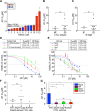BET inhibition in advanced cutaneous T cell lymphoma is synergistically potentiated by BCL2 inhibition or HDAC inhibition
- PMID: 30018745
- PMCID: PMC6044378
- DOI: 10.18632/oncotarget.25670
BET inhibition in advanced cutaneous T cell lymphoma is synergistically potentiated by BCL2 inhibition or HDAC inhibition
Abstract
While several systemic therapies are approved for cutaneous T cell lymphoma (CTCL), a non-Hodgkin lymphoma of skin-homing T cells that may involve lymph nodes and peripheral blood in advanced stages, relapses are common. Mutational analysis of CTCL cells has revealed frequent amplification of the MYC oncogene, and bromodomain and extraterminal (BET) protein inhibitors have been shown to repress MYC expression in various malignancies. Towards a potential novel therapy, we thus sought to examine the effect of BET inhibition on CTCL cells in vitro. Each of the four tested BET inhibitors (JQ1, ABBV-075, I-BET762, CPI-0610) consistently induced dose-dependent decreases in viability of isolated patient-derived CTCL cells and established CTCL cell lines (MyLa, Sez4, HH, Hut78). This effect was synergistically potentiated by combination of BET inhibition with BCL2 inhibition (e.g. venetoclax) or histone deacetylase (HDAC) inhibition (e.g. vorinostat or romidepsin). There was also a marked increase in caspase 3/7 activation when JQ1 was combined with either vorinostat or romidepsin, confirming that the observed synergies are due in major part to induction of apoptosis. Furthermore, MYC and BCL2 expression were each synergistically repressed when CTCL cells were treated with JQ1 plus HDAC inhibitors, suggesting cooperative activities at the level of epigenetic regulation. Taken together, these data indicate that targeting BET proteins in CTCL represents a promising novel therapeutic strategy that may be substantially potentiated by combination with BCL2 or HDAC inhibition.
Keywords: BET inhibition; CTCL; HDAC inhibition; apoptosis.
Conflict of interest statement
CONFLICTS OF INTEREST The authors declare no competing financial interests.
Figures





Comment in
-
Developing BET-ter treatments for cutaneous T-cell lymphoma.Oncotarget. 2019 Feb 12;10(13):1267-1268. doi: 10.18632/oncotarget.26662. eCollection 2019 Feb 12. Oncotarget. 2019. PMID: 30863486 Free PMC article. No abstract available.
-
Harnessing the synergistic potential of biologically targeted therapies in cutaneous T-cell lymphoma.Oncotarget. 2019 Mar 8;10(20):1860-1861. doi: 10.18632/oncotarget.26751. eCollection 2019 Mar 8. Oncotarget. 2019. PMID: 30956764 Free PMC article. No abstract available.
References
-
- Girardi M, Heald PW, Wilson LD. The pathogenesis of mycosis fungoides. N Engl J Med. 2004;350:1978–1988. - PubMed
-
- Kazakov DV, Burg G, Kempf W. Clinicopathological spectrum of mycosis fungoides. J Eur Acad Dermatol Venereol. 2004;18:397–415. - PubMed
-
- Wilcox RA. Cutaneous T-cell lymphoma: 2014 update on diagnosis, risk-stratification, and management. Am J Hematol. 2014;89:837–851. - PubMed
-
- Willemze R, Jaffe ES, Burg G, Cerroni L, Berti E, Swerdlow SH, Ralfkiaer E, Chimenti S, Diaz-Perez JL, Duncan LM, Grange F, Harris NL, Kempf W, et al. WHO-EORTC classification for cutaneous T cell lymphomas. Blood. 2005;105:3768–3785. - PubMed
LinkOut - more resources
Full Text Sources
Other Literature Sources
Research Materials

